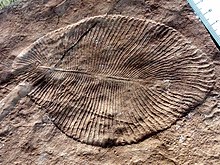The ancestors of pretty much all life-forms on Earth, existing and extinct, can be found in the Burgess Shale.
The Burgess Shale is located in the Canadian Rocky Mountains, in British Columbia's, Yoho National Park. The shale contains exceptionally preserved fossils of strange and weird animals, which have not been found anywhere else.
 |
| Dickinsonia fossil is the oldest known animal fossil, of the extinct genus of the Ediacaran biota. |
The shale preserves a complete ecosystem, which existed for only a very short period after the first multicellular life exploded into existence upon the earth.
During the Cambrian Period, plants and animals did not yet exist on the land, only marine plants and invertebrate animals lived in the Cambrian seas.
All of the major types of animal phyla that exist today are represented in the Burgess Shale. However, there are other creatures which cannot be placed in our modern classification system.
 |
| Reconstitution of a Pikaia from the Muséum national d'histoire naturelle |
Books To Read
Evolution, is a collection of short stories that work together to form an episodic science fiction novel by author Stephen Baxter.